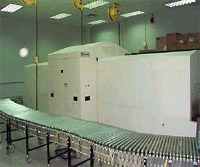 |
What's the Big Deal with Bags? |
||||||
|
The Coming Airport Meltdown In 1990 Congress required the FAA to screen passengers' checked bags by 1993. Now, twelve years later, we're doubtful about implementing screening by the end of the year. Most industry observers claim this is impossible, but the TSA surprisingly says 'no problem'. Some analysts suggest that delays caused by this new system will require three hour (or longer) checkin times!
Thie TSA is purchasing 1100+ of these mini-van sized luggage scanners, costing $1 million or more each. They are the most expensive - but not most effective - means of checking luggage.
|
What is so complicated about screening checked bags? Congress initially tasked the TSA to ensure that there was 100% checked baggage screening at all 429 US commercial airports by 31 December 2002. It is becoming increasingly obvious to everyone (except the TSA) that this is an impossible deadline. Congress has offered to extend this deadline. The TSA says it doesn't need an extension. But, proving the truth of the saying 'Haste makes Waste' the TSA also says it needs another $4 billion or else it will run out of funds very shortly! The TSA is becoming perhaps the most extensive and expensive government program ever, and one created with the least amount of public input or comment. Its pell-mell pursuit of baggage screening technology is a good example of all that is wrong with the supposed 'cure' to airport security. A Longstanding Problem The underlying need to screen checked luggage dates back to 21 December 1988 and the crash of Pan Am's flight 103, caused by a bomb in an unaccompanied piece of checked luggage. As a result of this obvious vulnerability, Congress sensibly enacted a requirement, in 1990, for the FAA to install explosives detection machines at airports by 1993. Unbelievably, twelve years later, this requirement has still not been met, and now the new TSA, successor to the FAA in terms of airport and airplane security, has been given until 31 December 2002 to complete this tasking. The Proposed Solution The TSA plans to install 1100 special baggage screening machines (EDS or Explosive Detection Systems) supplemented by another 4800 'sniffer' units. As for progress to date, there is both good news and bad news. The good news (sort of) is that current estimates suggest approximately 75% of US airports will be able to meet the 31 December deadline for screening all passenger bags. The bad news is that these are primarily small airports - 80% of all passengers will be traveling through the remaining 25% of airports! And the surprising news is that the TSA - already way behind schedule for taking over security at airports - continues to say that it does not need an extension of time for any airports to meet this deadline! All it needs is - ahem - more money. In a massive cost overrun, the TSA claims that it needs another $4 billion to cover its escalating costs. Good question! With twelve years to develop a response to the problem, and plenty of overseas examples to learn from, you'd think things would be simple and straightforward. Unfortunately, they're not. The TSA is adopting the most expensive method of bag testing, while ignoring other methods that are not only much cheaper but also potentially much better as well! EDS machines process 150-200 bags per hour, and have an annual operating cost of $510,000. By contrast, an automated X-ray machine (the least expensive option) can process 1200-1500 bags an hour with an annual cost of $90,000. Automated X-ray machines are therefore forty times cheaper, per screened bag, than these EDS machines. The automated X-ray technology is widely in use in major European airports such as Heathrow. They are proven, reliable, effective and affordable. Why are they being overlooked in the US? Problems with the EDS Units There are several problems associated with this technology. The first is that the two companies that manufacture the equipment are completely unable to supply enough units in time for the 31 December deadline - even if they doubled their current product capacity! The second problem is that the EDS units are the most expensive solution. This would be acceptable if EDS technology was universally accepted as being the 'best' and most certain method of explosive detection. The problem is that it is not. EDS units are prone to giving false 'positive' alarms - suggesting that items might be bombs but which are in fact not bombs (eg confusing chocolate for plastic explosive!). As much as 30% of the time, the unit gives false positive warnings, and I know from inconvenient personal experience that it then takes one or two security checkers ten minutes or more to painstakingly test every last item in the suitcase with explosive trace detectors to try and 'clear' the false positive alarm. This leads to the next problem. The EDS units are very slow. They're also very big (about the same size as a soccer mom's minivan). Airports will need lots of these units and many airports have no space for them! There's another problem, too. The units are very complicated and have shown to be somewhat unreliable - as much as a 30% downtime was experienced at SFO! Why Use EDS Units? EDS technology seems to be the least well suited to airport security needs. So why is the TSA single-mindedly adopting this approach? Some cynics would point out that one of the two suppliers of EDS equipment hired the lobbying firm that has Senator Majority Leader Tom Daschle's wife as a member; a short while thereafter that company was confirmed as a supplier of equipment. Indeed, in an unusually explicit directive from Congress, the FAA was directed to buy equal numbers of L-3 units as those of competitor InVision. Whether this really has any bearing on the case, or maybe someone simply thinks that because this is the most expensive technology, it is therefore the best technology, or maybe there is some other reason for choosing this approach; but whatever the situation, the result promises to be very problematic. So What Will Happen? Allow me to make a confident prediction. All airports will not have EDS units installed by 31 December. The TSA will have to make an embarrassing about face and ask for extra time. And if you're at an airport that has installed EDS units and implements a 100% EDS bag screen program, better plan on an extra hour or two of waiting time. Will We Be Safer? No. If a terrorist wishes to blow up a plane in mid-air, he'll simply consign a bomb as air freight and avoid all these security checks! So why are we spending literally billions of dollars on these units when (a) They are the most expensive choice? (b) It is difficult to consider them the best choice? (c) We're leaving open a massive loophole for terrorists to exploit such as to make the whole program ridiculous? I can't answer that question. Maybe your Congressman or Senators can! Related Articles, etc
Tell David your opinion. Send him an Email - [email protected]
Originally
written 19 Jul 2002, last update
21 Jul 2020 |
||||||
